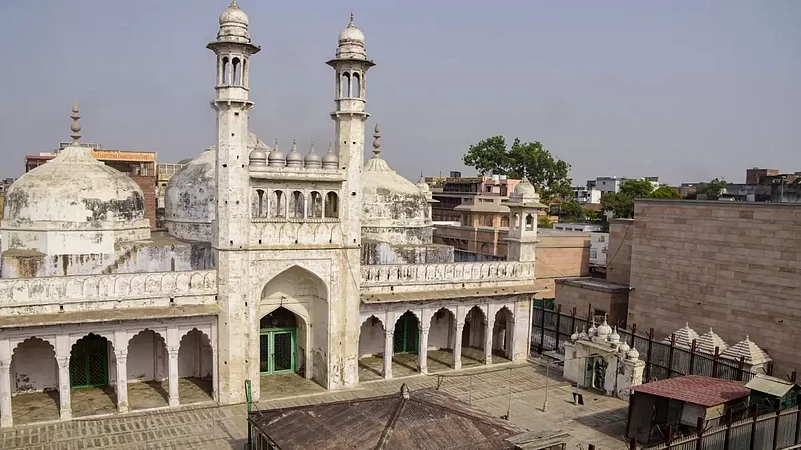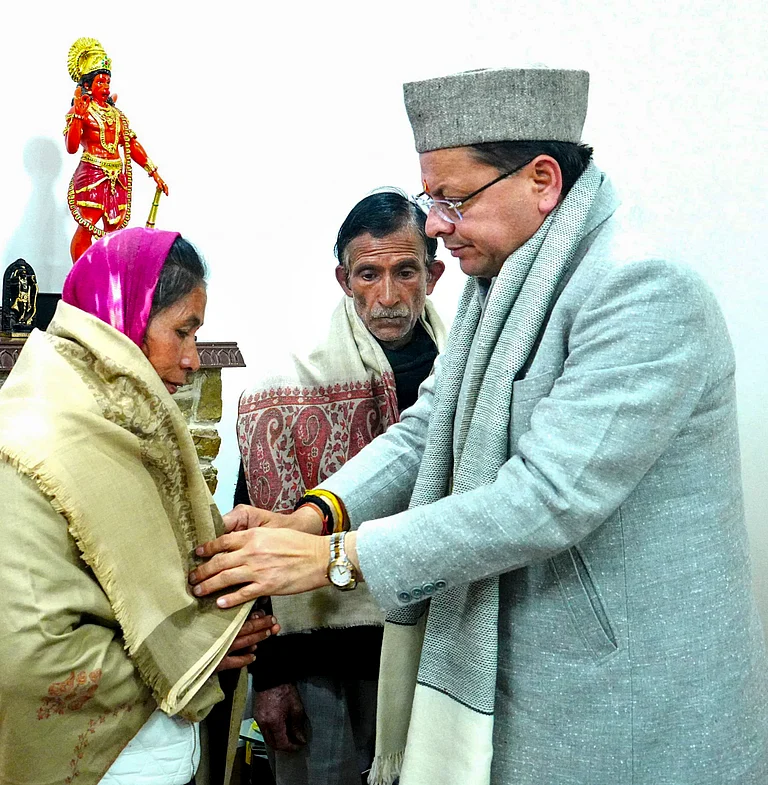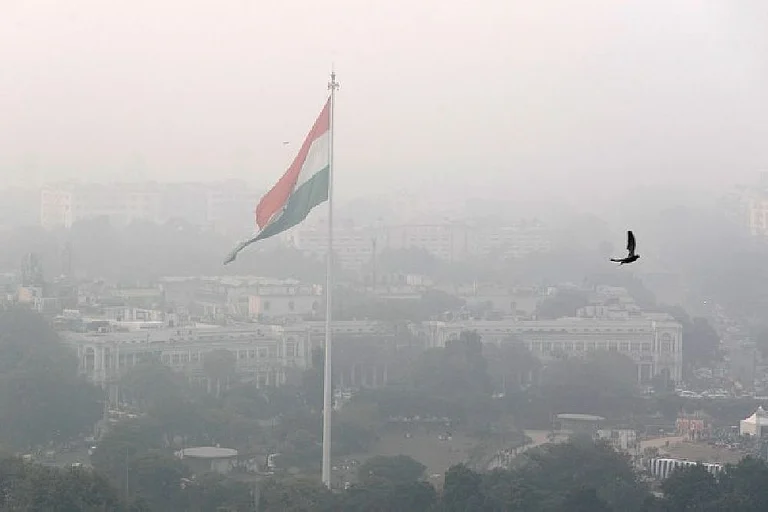In an order dealing with principles of law as well as history spanning centuries, the Allahabad High Court last month ruled that a clutch of petitions related to the Gyanvapi Compound in Uttar Pradesh’s Varanasi were not barred by the Places of Worship (PoW) Act, 1991.
The PoW Act locks the religious character of any place of worship as it existed on August 15, 1947, and bars any effort or litigation for the conversion of a place of worship. Following the High Court’s order, the petitions regarding the Gyanvapi Compound will proceed in the Varanasi District Court.
The UP Sunni Central Waqf Board and the Anjuman Intazamia Masazid Varanasi had sought the cancellation of the Gyanvapi-related petitions under a provision of a Code of Civil Procedure (CPC), 1908, that says a plaint can be rejected if it appears to be barred by an existing law at the first reading. Delhi-based lawyer Sarim Naved says the Allahabad HC’s order was therefore one dealing with the technicalities of the law and does not serve as the final word on the PoW Act.
In the 63-page order, Justice Rohit Ranjan Agarwal ruled that the determination of the religious character of the Gyanvapi Compound —as one of the petitions seeks— does not amount to a conversion of its religious character. He further ruled that only a competent court may decide the character of a site in dispute.
The Gyanvapi Compound in Varanasi is located right next to the Kashi Vishwanath Temple, one of the holiest sites for Hindus. The temple complex was razed multiple times in the medieval period. In the petitions in the court, it has been claimed that there are religious icons on the outer walls of the Gyanvapi Compound and that Hindu devotees should be given daily prayer rights. Another petition sought a survey —which has been conducted and the report has been filed— to determine if the mosque in the compound was built on the ruins of the medieval temples. A petition from 1991 also seeks the handover of the compound to the Hindus based on such a claim.
The Allahabad High Court’s ruling therefore marks a key moment in a case that carries wide sociopolitical ramifications. After the Ram Janmabhoomi judgement in 2019, Hindu groups turned their focus to Varanasi and Mathura as well — two other cities sacred to Hindus. “Ayodhya to bas jhaanki hai, Mathura-Kashi baanki hai (Ayodhya is just a glimpse, Mathura and Kashi are left)” was a popular saying in the Ram Mandir movement of 1980-90s.
What’s Places Of Worship Act, Why Was It Enacted?
The Places of Worship (PoW) Act, 1991, was enacted by the then-Prime Minister PV Narasimha Rao’s government at the height of the Ram Mandir movement. The intention behind the law was to not let the temple movement spread beyond Ayodhya amid plans to ‘reclaim’ sites in Mathura and Varanasi as well.
The brief law —running into just eight sections and two pages— locks the religious characters of places of worship as it existed on August 15, 1947, and bars any effort or litigation seeking any conversion. The law also penalises such conversion, attempt to conversion, and conspiring for such a conversation.
“No person shall convert any place of worship of any religious denomination or any section thereof into a place of worship of a different section of the same religious denomination or of a different religious denomination or any section thereof,” says Section 3 of the PoW Act.
The law further says that any lawsuit seeking such conversion of the religious character of the place of worship before the enactment of the law would cease to exist and no appeal can be filed regarding it. Section 4 of the PoW Act states that “any suit, appeal or other proceeding with respect to the conversion of the religious character of any place of worship, existing on the 15th day of August, 1947, is pending before any court, tribunal or other authority, the same shall abate, and no suit, appeal or other proceeding with respect to any such matter shall lie on or after such commencement in any court, tribunal or other authority”.
There are, however, certain exceptions to the law. Places of worship under the Archaeological Survey of India (ASI) or any conversion of a place of worship “effected before such commencement [of the law] by acquiescence” are exempted from the law.
In the landmark Ram Janmabhoomi judgement, the Supreme Court devoted a whole section of the PoW Act and said that the law serves as a tool to not hold the present and future captive over historical wrongs and serves the belief that such wrongs should have been buried at the Independence and the nation should have made a fresh start.
“There is a purpose underlying the enactment of the Places of Worship Act. The law speaks to our history and to the future of the nation. Cognizant as we are of our history and of the need for the nation to confront it, Independence was a watershed moment to heal the wounds of the past. Historical wrongs cannot be remedied by the people taking the law in their own hands. In preserving the character of places of public worship, Parliament has mandated in no uncertain terms that history and its wrongs shall not be used as instruments to oppress the present and the future,” said the Constitution Bench of the Apex Court in its unanimous judgement.
Gyanvapi Case And Places Of Worship Act
The UP Sunni Central Waqf Board and the Gyanvapi mosque committee had challenged the petitions related to the Gyanvapi Compound by arguing that these were barred by the Places of Worship (PoW) Act, 1991. They argued that the status of the site in question had been decided in pre-Independence India in the ‘Din Mohammad and Others vs. The Secretary of State for India’ case in which the courts ruled it to be a mosque.
The challenge in the Allahabad High Court was on a very technical ground, according to Delhi-based lawyer Sarim Naved. He tells Outlook, “The plaintiffs had sought the rejection of petitions related to the Gyanvapi case on grounds of Order 7, Rule 11 of the Code of Civil Procedure (CPC), which deals with the rejection of the petition if it’s wrong or barred by a law on its first reading. While I believe the ruling should have been otherwise, the High Court’s order is not the final word on the Places of Worship Act of the Gyanvapi petitions.”
The Allahabad High Court ruled that the rejection under Order 7, Rule 11 “applies to those cases only where a statement made by plaintiffs in the plaint, without any doubt or dispute shows that suit is barred by any law in force”. As such a case does not apply to the matter at hand, the HC rejected the arguments of the Waqf and mosque committee. The Allahabad High Court ruled that the petitions were not seeking a conversion of the character of a place of worship —the Gyanvapi Mosque— but were seeking the determination of character.
Naved says the PoW Act is likely to prevail even if the argument of seeking the determination of character goes through. “The PoW Act is very clear that a place of worship cannot be converted. This means that even if the religious character of a place is determined otherwise, the law is likely to prevail and the court is likely to rule in the end that, as the PoW Act stands, the place of worship will not be converted and the control will not be handed over,” says Naved.
Such a situation should never arise at all though, says Naved. He tells Outlook, “The idea behind the Places of Worship Act was to prevent such litigation in the first place. Even if the law prevails in the end, such a lengthy process should never happen as the law intended to rest all such litigation at the onset.”
Gyanvapi’s Religious Character Not Established: Allahabad HC
The Allahabad High Court in its order also rejected the Waqf and mosque committee’s contention that the ‘Din Mohammad and Others vs. The Secretary of State for India’ case (1942) confirms the Gyanvapi Compound’s status as a mosque. The HC ruled that the site “cannot be said to have religious character of a ‘mosque’ at this stage”.
“The decision of Din Mohammad does not lay down religious character of the disputed place, and it only permits plaintiffs therein to offer namaz in the alleged Mosque,” said the HC.
The High Court further said the ‘Hindu’ and ‘Muslim’ sides were not parties of the ‘Din Mohammad’ case and the verdict was in favour of three Muslim plaintiffs in their individual capacity and not to the Muslim community as a whole.
“Thus, it is clear that once the parties to the present lis were not a party in suit filed by Din Mohammad, the religious character of the disputed structure cannot be termed as ‘mosque’ as the relief granted was in persona to the plaintiffs therein,” said the Allahabad HC.
The High Court ruled that the bar imposed by the PoW Act is not absolute as the matter of hand falls under one of the exceptions. The HC noted that “where conversion has taken place much before the commencement of the Act and a party had not approached the court, the acquiescence or silence would not bar the action of such party”.
The Allahabad HC further noted that the PoW Act does not define ‘religious character’ and only defines ‘conversion’ and ‘place of worship’. In such a case, only a competent court may be only route for such determination, said the court.
“The Act does not define ‘religious character’, and only ‘conversion’ and ‘place of worship’ have been defined under the Act. What will be the religious character of the disputed place can only be arrived by the competent court after the evidences are led by the parties to the suit…Either the Gyanvapi Compound has a Hindu religious character or a Muslim religious character. It can’t have dual character at the same time. The religious character has to be ascertained by the Court considering pleadings of the parties, and evidences led in support of pleadings,” ruled the HC.
Legal Challenge To Places Of Worship Act
The Places of Worship (PoW) Act, 1991, is not without its criticism. Its constitutionality has been challenged in the Supreme Court and the challenge is currently pending before the Apex Court.
Ashwini Kumar Upadhyay has challenged the constitutionality of the PoW Act on the grounds that it does not allow judicial review, which is part of the Basic Structure of the Constitution of India — emanating from the landmark Kesavananda Bharati judgement of the Supreme Court. He has also contended that the law violates secular principles of the Constitution as it disfavours particular communities who have suffered historical wrongs.
Shedding light on the provisions of the law and the challenge it is facing, legal expert Vinod Shankar Mishra tells Outlook that the PoW Act prohibits litigation related to places of worship and it’s deemed against the inherent powers of the court and existing precedents.
“The PoW Act faces criticism because it restricts judicial review, a basic feature of the Constitution,” says Mishra, Professor, Faculty of Law, Banaras Hindu University (BHU). Drawing a parallel with the Supreme Court’s striking down of the 99th Constitutional Amendment in 2015, he underscores that even constitutional amendments can be invalidated. Mishra adds, “The PoW Act, being an ordinary law, therefore faces a challenge on this ground. Moreover, it is also asserted that it infringes on the fundamental right to religious freedom under Articles 25 and 26 of the Constitution by preventing legal challenges to historic wrongs, such as destruction or occupation of religious sites.”
In his petition, Upadhyay argued that Hindus, Sikhs, Jains, and Buddhists are adversely affected by the law as their religious sites were razed or occupied in the past and the law bars them from any legal relief today. This, said his plea, violates their fundamental right to freedom of religion.
Throughout the medieval period, several religious sites were razed, most notably during the Delhi Sultanate and Mughal periods. These included some of the holiest Hindu sites at Banaras and Mathura. In his book ‘Medieval India: From the Sultanate to the Mughals, Volume 2’, historian Satish Chandra notes that while initially, Mughal Emperor Aurangzeb’s policy was to allow old temples to run but prevent newer ones’ construction, he later started ordering the destruction of even older and important temples in retribution to sociopolitical opposition.
“As Aurangzeb encountered political opposition from a number of quarters, such as Marathas, Jats, etc., he seems to have adopted a new stance. In case of conflict with local elements, he now considered it legitimate to destroy even longstanding Hindu temples as a measure of punishment and as a warning,” wrote Chandra.
He further wrote, “As a result of these orders, a number of temples such as the famous temple of Vishwanath at Banaras, and the temple of Keshava Rai at Mathura built by Bir Singh Deo Bundela in the reign of Jahangir were destroyed and mosques erected in their place.”
It was only the latest destruction of the Vishwanath Temple. In her book ‘Flight of the Deities and Rebirth of Temples’, historian Meenakshi Jain notes that the temple was razed at least twice earlier — first by Delhi Sultan Qutb ud-Din Aibak in 1194 and then by Raziya Sultan during her short reign during 1236-40.
According to Mishra, those challenging the law argue that the inability to litigate against such actions gives legitimacy to such occupation and destruction, violating their right to seek justice. Moreover, the petitioners contend that the law discriminates against certain communities that have historically lost more religious sites during the medieval period, says Mishra.
Addressing the Allahabad High Court’s order in the Gyanvapi case, Mishra clarifies that it is not the final judgment on the Places of Worship Act. “The final word will come from the Supreme Court. The PoW Act remains in force despite the High Court’s order. If the Supreme Court deems the law unconstitutional, the Doctrine of Severability suggests that only specific sections may be struck down, leaving the rest of the law intact,” says Mishra.
Mishra highlights another key criticism of the PoW Act: the lack of definition of ‘religious character’. This lack of definition leaves the determination of the disputed place’s religious character to be decided by a competent court after parties present evidence during legal proceedings, says Mishra.
“While the law specifically bars the conversion of places of worship, it lacks a clear definition or procedure for determining the religious character of a place that existed on August 15, 1947,” says Mishra.


























